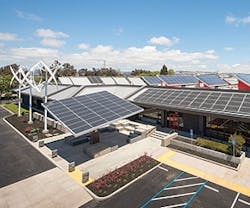Zero net energy consumption is becoming increasingly viable for existing buildings.
In fact, 24% of projects verified as consuming zero net energy are renovated buildings, according to the New Buildings Institute (NBI) in its recently released 2014 Getting to Zero Status Update, a new version of a 2012 report. The number of buildings with either verified performance or progress toward a goal of zero has more than doubled in the last two years, from 60 in 2012 to 160 in 2014.
While zero net energy is not yet common as a design goal, the NBI’s analysis of the 33 verified new and existing projects (including one district) reveals that in many cases, the cost to construct a zero net energy building is comparable to that of like buildings constructed conventionally.
“Our research indicates that zero net energy projects are achievable all over the country and involve typical high-performance building strategies,” explains Amy Cortese, senior program manager for the New Buildings Institute. “But it’s more than just careful attention to design and the right technologies – it goes all the way through the operations and occupancy of the building. Ongoing attention to performance is especially important.”
Zero Net Energy in Action
Among the buildings profiled in the report is a 46,000-square-foot training center in San Leandro, CA, currently awaiting certification. Its owners, IBEW Local 595 and the Northern California chapter of NECA, needed to renovate their 1980s-era building into a state-of-the-art educational facility to train electricians and electrical contractors on the latest energy efficiency strategies. After six months of design charrettes and extensive conversations, the team realized zero net energy was within reach.
“We decided to pursue zero net energy because we wanted to reflect what we’re about to the best of our ability,” explains Byron Benton, training director for the Alameda County Electrical Joint Apprenticeship Training Committee, a joint educational association between Local 595 and NorCal NECA. “The work we do, the systems we train on – this facility matches our values. We wanted to walk the walk, not just talk the talk.”
The Bay Area is home to several zero net energy buildings, but most were new construction projects. The educational component posed an additional challenge, as the systems chosen for the building had to provide varied hands-on training opportunities for IBEW electricians and NECA contractors. This requirement ultimately resulted in the installation of both flat and tilted roof-mounted PV panels, a dual-axis solar tree, and three 12 kW wind turbines that provide a variety of training environments.
Other common challenges for would-be zero-net buildings include limited roof and site space for PV panels or insufficient funding available for the needed PV capacity, according to the NBI study.
Complementing the renewable energy generation is a suite of ultra-efficient building systems designed to drive energy use as low as possible, Benton adds. Passive heating and ventilation are assisted by roof monitors that also contribute to daylighting, while mechanical heating and cooling are provided as needed by four variable refrigerant flow units. Building systems are also linked to an automation system, as are the operable windows.
The project was completed in 2013. Its energy consumption status will be verified after 12 months of meeting its net energy use through on-site generation with renewables.
“It starts with making a building as efficient as you can make it,” Benton says. “We started with reducing our energy consumption as much as possible – that’s why our building uses 75% less energy than the same size and type of building elsewhere. You can get to zero energy by throwing on tons of solar and wind, but the more responsible way to do it is to reduce energy use first.”
Chart Your Path
The key to achieving zero net energy consumption is starting early and choosing zero as a goal as early as possible, says Cortese. Early targets also help manage costs, according to the study. However, projects that don’t aim for zero can still achieve minimum energy consumption with widely available retrofit strategies.
“Zero net energy is one thing, but ultra-low energy is definitely within reach,” Cortese explains. “The buildings in this study are pretty typical retrofits, including some examples of people renovating buildings that didn’t have much hope or that had been abandoned for decades.”
To learn more about the training center, visit znecenter.org. The full NBI study is available at newbuildings.org.
About the Author
Janelle Penny
Editor-in-Chief at BUILDINGS
Janelle Penny has been with BUILDINGS since 2010. She is a two-time FOLIO: Eddie award winner who aims to deliver practical, actionable content for building owners and facilities professionals.

